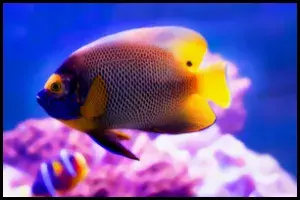
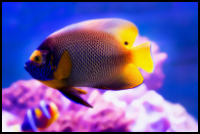
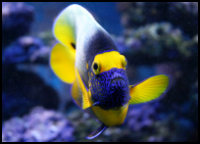

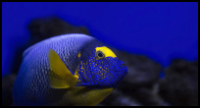
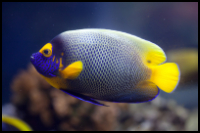
Quick Care Details (Table)
| Livestock Characteristics | Value |
|---|---|
| Care Level | Moderate |
| Temperament | Semi-Aggressive |
| Diet | Omnivore |
| Maximum Size | 1ft & 3 Inches |
| Minimum Tank Size | 220 Gallons |
| Reef Compatible | With Caution |
| Temperature Range | 72-78F |
| PH Range | 8.1-8.4 |
| DKH Range | 8-12 |
| Salinity Range | 1.020-1.025 |
Species Specific Categories
Helpful Video
Care Details
Aquascape: When you're setting up an aquarium for Blueface Angelfish, think about creating an underwater environment that resembles their natural habitat. These fish are typically found in coral reefs, so it's a good idea to include live rocks with plenty of hiding spots. Adding soft and hard corals not only enhances the tank's beauty but also provides shelter for the Blueface Angelfish.
Substrate: Go for a sandy substrate at the bottom of the tank. These fish might sometimes dig around, so make sure the sand layer is deep enough to prevent them from disturbing the tank's base.
Disease Prevention: Preventing diseases is crucial. Before adding new fish to your tank, it's a good practice to quarantine them for a few weeks. This helps ensure they are healthy and free from illnesses. Maintaining good water quality, a stable salinity level, and providing a balanced diet will help reduce stress and make your fish less susceptible to diseases.
Filtration: You'll want a reliable and effective filtration system in place. A high-quality protein skimmer, both mechanical and biological filtration, and regular water changes are essential for keeping the water in excellent condition. Blueface Angelfish, being relatively large fish, produce a fair amount of waste, so robust filtration is a must.
Lighting: These fish don't have specific lighting requirements since they don't rely on photosynthetic corals. However, if you decide to keep corals or invertebrates in the tank, make sure to provide suitable lighting for their needs.
Water Flow: Blueface Angelfish prefer moderate water flow. This simulates their natural habitat where they can seek shelter from strong currents within the reef. Ensure there are no stagnant areas in the tank by positioning powerheads or wave makers strategically.
Hardiness: While Blueface Angelfish are relatively hardy, it's important to maintain stable water conditions. Fluctuations in water parameters can stress them and make them more susceptible to diseases. Regular monitoring and maintenance are key to their well-being.
Acclimation: When introducing Blueface Angelfish to a new tank, it's best to acclimate them gradually to the tank's water parameters over a period of time. This reduces stress and helps them adapt more comfortably to their new environment.
Expected Lifespan: With proper care in a well-maintained tank, Blueface Angelfish can live for 10-15 years or more. The quality of care and the environment you provide play a significant role in determining their lifespan.
Special Requirements: Blueface Angelfish aren't the best choice for novice aquarists due to their territorial behavior and specific dietary needs. They can be aggressive toward other angelfish and similar species, so selecting tank mates carefully is important. A roomy tank with plenty of hiding spots is essential, especially if you plan to keep multiple angelfish. Be prepared to meet their dietary requirements, as they primarily feed on sponges and tunicates in the wild.
Temperament and Behavior
Behavior and Social Interaction: Blueface Angelfish are known for their interesting and somewhat territorial behavior. They can be quite curious and responsive to their surroundings, making them engaging to observe. But do keep in mind that their territorial nature can lead to some aggression, especially when they feel their space is threatened.
Aggression: These angelfish can be a bit feisty, particularly when introduced to other angelfish or similar species. To minimize conflicts, it's a good idea to introduce them to the tank last and provide hiding spots to reduce confrontations.
Breeding: Breeding Blueface Angelfish in captivity is quite a challenge. It typically requires a large, mature tank, and even then, it's not always successful. Most Blueface Angelfish in aquariums are usually caught in the wild.
Compatibility with Inverts and Fish: Blueface Angelfish aren't usually considered "reef-safe." They might nibble on and damage corals and invertebrates, particularly the softer corals. When it comes to other fish, their compatibility depends on factors like the tank's size and the temperament of their tankmates. Avoid keeping them with other angelfish or aggressive species.
Activity Level: These angelfish have a moderate activity level. They enjoy exploring their environment and are often quite inquisitive.
Clean-Up Crew: Blueface Angelfish aren't known for playing the role of "clean-up crew" in your tank. They don't typically eat algae or perform cleaning tasks like certain other fish species.
Schooling or Shoaling Behavior: Blueface Angelfish don't exhibit schooling or shoaling behavior. They prefer to have their own territory and can be territorial when it comes to other fish encroaching on their space.
Coral Reef Compatibility: While they're often found in coral reef environments in the wild, it's important to note that Blueface Angelfish are generally not considered reef-safe in captivity due to their coral-nipping tendencies. They are better suited for fish-only or FOWLR (Fish Only With Live Rock) setups.
Diet and Nutrition
Dry Foods: Blueface Angelfish can be trained to enjoy high-quality marine flakes and pellets, which are convenient staples in their diet. However, it's essential to mix in other food types to provide a well-rounded nutrition.
Frozen Foods: Incorporate frozen foods such as brine shrimp, mysis shrimp, and seafood blends. These options are rich in nutrients and replicate the variety of their natural diet.
Live Foods: Blueface Angelfish have a penchant for live foods, like small crustaceans and worms. Offering live brine shrimp or even small feeder fish now and then can make their diet more exciting and nutritionally diverse.
Vegetables: These fish, being primarily omnivorous, do consume marine-based vegetables like seaweed or spirulina. These can contribute to their diet, particularly the plant-based component and some algae, replicating their natural food sources.
Algae: Indeed, Blueface Angelfish do consume algae as part of their natural diet. Providing some algae, such as seaweed sheets or spirulina flakes, can be beneficial for their health.
Feeding Schedule: Maintain a regular feeding schedule with small, frequent meals throughout the day. This mimics their natural foraging behavior, ensures steady energy levels, and reduces the risk of overeating.
Supplemental Foods: To keep them in prime health, consider adding vitamin and mineral supplements to their diet. You can introduce these supplements by soaking their food or using liquid additives to meet their specific dietary requirements.
Tank Parameters
Tank Size: These angelfish are on the larger side, so they need a roomy home. To keep a single Blueface Angelfish, you'll want a tank of at least 125 gallons. If you plan to have more than one, go for an even bigger tank to minimize territorial conflicts.
Tank Length and Measurements: A tank that's about 6 feet long (around 1.8 meters) is ideal. This length provides them with the swimming space they need and comfortably accommodates their size.
Species Maximum Size: Blueface Angelfish can grow quite large. Juveniles start at around 3-4 inches, but adults can reach up to a substantial 15 inches. So, their tank should reflect their adult size.
Water Temperature: Keep the water temperature in the range of 74-78°F (23-26°C). This range is similar to the warm waters of their natural habitat.
pH (Acidity/Alkalinity): Aim for a pH level between 8.1 to 8.4, which replicates the conditions of their coral reef home.
Nitrate (NO3) Levels: Keep nitrate levels as low as possible, ideally below 10 ppm. This is achieved through regular water changes and efficient filtration.
Salinity: Maintain a stable salinity level between 1.020 and 1.025, matching their marine environment.
Phosphate (PO4): It's important to keep phosphate levels low, preferably below 0.03 ppm. High phosphate levels can lead to algae problems in the tank.
Alkalinity (dKH): Aim for an alkalinity level between 8-12 dKH. This range supports healthy water chemistry, benefiting not just the Blueface Angelfish but also the corals and marine life in their tank.
History, Popularity, History and Species Variety Details
The History, Popularity and Natural Habitat
History: Blueface Angelfish, scientifically known as Pomacanthus xanthometopon, has been a fascination for marine enthusiasts for quite a while. These beautiful fish were officially described by a French naturalist named Achille Valenciennes back in the mid-19th century. Since then, they've been catching the eye of aquarists with their vibrant colors and graceful appearance.
Popularity: Blueface Angelfish holds a special place in the hearts of aquarium enthusiasts. Their electric blue faces and stunning hues make them a highly sought-after addition to marine tanks. But it's worth noting that they come with specific care requirements, so they're often a preferred choice for more experienced aquarium keepers.
Natural Habitat: Blueface Angelfish make their home in the warm waters of the Indo-Pacific region, especially in the Pacific Ocean. In their natural surroundings, you'll find them on coral reefs, blending in with the colorful marine life. They typically roam at depths ranging from 3 to 20 meters, where they explore coral formations and seek shelter among the nooks and crannies of the reef. With their mesmerizing appearance, they're like underwater jewels, whether in their native habitat or in well-maintained aquariums.
- Halfmoon Angelfish (Pomacanthus semicirculatus): This one is often considered a close cousin of the Blueface Angelfish. It has the same body shape but skips the electric blue face. Instead, it rocks a vibrant blue crescent marking on its body, which is how it got its name.
- Gray Angelfish (Pomacanthus arcuatus): The Gray Angelfish is like the Blueface Angelfish's understated sibling. It has a more mellow gray or silver color and subtle patterns. So, it's not as flashy as the Blueface.
- Emperor Angelfish (Pomacanthus imperator): Now, the Emperor Angelfish is another related species. It's a bit of a showstopper with its bold and intricate coloration. You'll see striking blue and yellow stripes, circles, and patterns all over its body. It's the royalty of the angelfish world.
- Regal Angelfish (Pygoplites diacanthus): The Regal Angelfish is a true head-turner. Its deep blue body, adorned with bright yellow and white stripes, gives it an air of royalty. It's like the crown jewel in a reef tank.
- Koran Angelfish (Pomacanthus semicirculatus): Picture this one as the artist of the angelfish world, with its unique crescent-shaped artistry. It's a canvas of blue, yellow, and black hues, a captivating choice for larger marine setups.
Back to top
Frequently Asked Questions
How large do Blueface Angelfish grow?
Blueface Angelfish can grow to a substantial size, with adults reaching up to 15 inches (38 cm) in length.
What's the best tank size for Blueface Angelfish?
A tank size of at least 220 gallons is recommended for a single Blueface Angelfish. Larger tanks are needed if you plan to keep more than one.
Are Blueface Angelfish reef-safe?
They are not considered reef-safe due to their tendency to nip at and potentially damage corals. It's best to avoid keeping them with delicate corals.
What should I feed Blueface Angelfish?
Their diet should include a mix of marine flakes, pellets, frozen foods, live foods, and marine-based vegetables to provide a well-rounded nutrition.
Do Blueface Angelfish eat algae?
Yes, they do consume some algae as part of their natural diet, so it's beneficial to offer marine-based vegetables and algae sheets.
How can I prevent aggression in Blueface Angelfish?
Introduce them last when adding fish to your tank, provide hiding spots, and carefully choose tankmates to minimize territorial disputes and aggression.
Can Blueface Angelfish be bred in captivity?
Breeding them in captivity is challenging and often requires a large, mature tank. Most Blueface Angelfish in aquariums are wild-caught.
What's the lifespan of Blueface Angelfish?
With proper care, they can live up to 10-15 years or even longer in well-maintained aquariums.
Do Blueface Angelfish get along with other fish in the tank?
Their compatibility with other fish depends on the tank's size and the temperament of tankmates. Avoid keeping them with other angelfish and aggressive species.
What are the common health concerns for Blueface Angelfish?
Some potential health issues include parasitic infections, such as marine velvet and ich. Quarantining new arrivals and maintaining good water quality can help prevent these problems.
Can I keep more than one Blueface Angelfish in the same tank?
Keeping multiple Blueface Angelfish in the same tank can lead to territorial disputes and aggression. It's often best to keep them singly or in larger tanks with ample hiding places.

